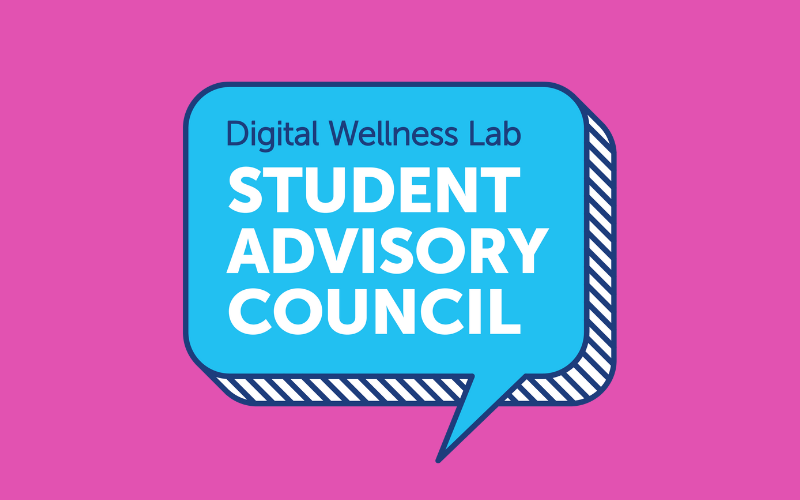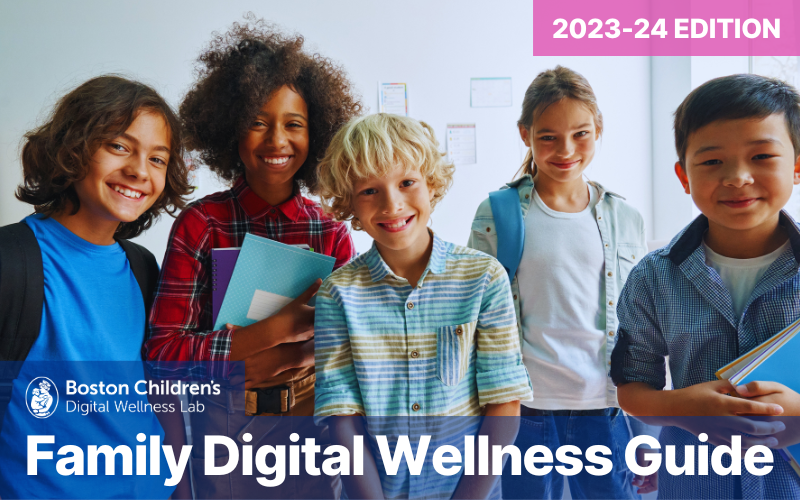Family Digital Wellness Guide
Teen to Young Adult (Ages 13-22)
Foster Independence with Support and Empathy

Adolescence is a transformative period of growth, exploration, and identity formation, and for most teens, technology is deeply integrated into their daily lives. From social media to online learning platforms, digital tools provide opportunities for self-expression, connection, and discovery. However, this stage also introduces new challenges, including managing social pressures, navigating misinformation, and striking a balance between screen time and other priorities. As teens gain more independence, it’s important to strike a balance in your approach — providing guidance while respecting their growing autonomy.
One way to do this is by maintaining open lines of communication about their online experiences. Initiate conversations about topics like cyberbullying, digital privacy, and the potential effects of social media on self-esteem, helping teens think critically about what they encounter online. Rather than imposing strict rules, involve them in creating family guidelines for technology use. Adolescents are more likely to follow boundaries they feel are fair and collaboratively developed, and these discussions can foster trust and mutual respect.
At the same time, encourage your teen to develop healthy habits around their digital use. Model practices like taking breaks from screens, setting aside device-free time during family activities, and using technology to foster empathy and connection. Emphasizing balance — both online and offline — can help teens manage their time and energy more effectively.
Finally, remember that your relationship with your teen plays a significant role in how they navigate their digital world. Providing a supportive and understanding environment allows them to come to you with questions or concerns about their online experiences. By equipping them with critical thinking skills and fostering a safe, open dialogue, you empower them to use technology in ways that are thoughtful, safe, and aligned with their long-term wellbeing.
Next section: What the Science Says
What the Science Says
Teens (13-18) and Young Adults (19-22)
Adolescence is an active period of change finalizing the shift from childhood to adulthood. Teens are maturing physically, sexually, and cognitively while they also develop more complex and nuanced relationships with peers and seek even greater independence from primary caregivers.
Friends become the predominant connection during adolescence, offering a safe space and emotional independence from parents, teachers, and other adults. Teens form more mature friendships and romantic relationships and they begin to feel a greater need to establish their own sexual identity. Social connectedness is integral to teens’ long term wellness outcomes.
Though their brains haven’t yet achieved the maturity levels of adulthood, teens’ brains become more capable of future thinking and logical problem solving. They are developing more complex understandings of human relationships, emotional nuance, and their own morals and values systems.
Screens and interactive media form an important part of teens’ and young adults’ social lives, education, and entertainment choices with teens and young adults engaged in a constant and often simultaneous interaction with the online world alongside their “real life” world.
In 2021, teens spent an average of eight hours and thirty-nine minutes on screen use, not including time spent for school, and 62% of teens responded that they use social media every day and eighty-four percent of young adults report ever using social media. Nearly 100% of teens report having access to a smartphone or home computer, and nearly half of teens report that they are online “almost constantly”. Sixty percent of teens report using computers to do their homework every day. But it’s important to remember that the measure of average time includes multi-tasking time, and teens aren’t necessarily spending that long looking at a screen. They might be playing video games with friends and video chatting on their phones instead of using in-game communication features, essentially squeezing multiple hours worth of entertainment media into one.
Much of teens’ social connection is happening on smartphones, which have made it increasingly easier to stay connected at all times. A recent report from Common Sense Media found that half of the teen participants were receiving 237 or more notifications a day from messages and apps. At 13, 70% of teens have their own smartphone; by 18 that number jumps to 93%.
Although many children are using social media before they turn 13, that is the “official” age where most social media platforms allow users to create their own profiles. Research on the social, emotional, and mental health impacts of social media continues to develop — evidence is mixed on the negative and positive effects of using it and how dramatic those effects are. The effects of social media may differ for teens based on many different factors in their life. But research also shows that active parenting practices about social media and monitoring use in a way that still respects their child’s autonomy may be protective, reducing mental health risks and minimizing cyberbullying effects. In one of our 2023 Pulse Surveys, over half of teens who reported having rules around their media use felt that they were just the right amount of restrictive — so teens are not opposed to rules from family.
For teens and young adults, and for girls in particular, it is important to discuss how social media can affect body image. Research has suggested that using social media and being focused on appearance-related activities, like comparing themselves to their peers or the “ideal” bodies on social media platforms, may be associated with a higher risk of depression and social anxiety. However, there is also evidence that teaching young teens in school and at home about the risks of comparing themselves to images of friends and celebrities, understanding how images might be curated or edited, and supporting self-esteem and confidence, may protect teens against the harms of social media comparison.
As teens’ sexual identity becomes more established, teens and young adults may turn to the internet for information. This is particularly true for LGBTQ+ teens, who may not be provided as much information in sexual education classes. Some teens are sexting, and while this is usually consensual, girls are more likely to report that they were pressured into sending images of themself, and similarly, boys were more likely to respond that they would ask for sexual pictures from a partner. 73% of teens are exposed to porn by the time they are 17, with over half of teens reporting the first time they saw porn online was before they were 13. LGBTQ+ teens and cisgender boys were most likely to report viewing porn on purpose, but often report using it in ways that explore their sexuality – for LGBTQ+ teens in particular, using porn may be a way teens feel safe exploring their preferences for a partner when they are uncomfortable talking about it to peers or adults.
As they strike off more independently into the online world, teens and young adults need opportunities to take risks with safety nets and to rely on their caregivers and trusted adults for support and guidance.
Parents should talk with their teens often about the experiences they are having and the choices they are making online. And as with children of every age, evaluating your own media practices to ensure you are modeling media behaviors you want your teen to emulate, such as putting away devices during family meals and staying undistracted by media during family interactions, will go a long way towards helping your teen build healthy habits (see best practices below for guidance).
Ideal Use
Parents should support their teens’ and young adults’ media boundaries, but intervene when necessary (see best practices below for guidance) to help them stay safe and healthy online while building skills for lifelong digital wellness.
Next section: Best Practices
Best Practices for Digital Wellness
Birth-Preschool
Sitting down with your teen to craft a shared media use agreement that addresses everyone in the family’s use of television, tablet, computer, smartphone, gaming, and other devices can set expectations and opportunities for holding one another accountable. It’s important that teens and young adults have input on the agreement and that everyone signs on. A recent research article indicates that autonomy-supportive restrictive parenting was associated with less media time. An example is setting rules and limits for media use, but discussing with and explaining to your teen why you are making those decisions. A media use agreement can be a great tool for this.
By working together with your teen to create a media use agreement — and to update it as they grow increasingly independent and responsible about their media use — you can help them build the habits that will lead to a healthier, more balanced engagement with the digital world.
During the teen years, talk with your teen about expectations for digital management and help them to create habits around putting away their phone before bed, designing schedules for exercise and other offline time, and identifying focus settings for schoolwork to avoid multitasking with media. These habits will carry into college and independent life when they get older.
Apps that allow parental restrictions on a minor child’s phone are common, but Common Sense Media’s recent research found that parental control apps sent the most notifications during school hours, sending a median of almost 30 notifications during the school day! Also, many teens report that their own management techniques, like turning on do not disturb or carefully curating which apps they will get notifications from, was often more helpful than parental restrictions, which some respondents felt like they were more likely to go against than their own tactics. Talk with your teen about their media experiences regularly and how they are feeling about the time they’re spending using media outside of schoolwork-related use and the content they are consuming — ask them how they feel they would best be able to manage any concerns they have about time or content, and work together to create and test solutions.
As they begin to navigate the online world more independently, teens will be making important decisions every day. Enabling their ability to address problems and make decisions on their own will support your teen’s long-term positive life outcomes. And in their online life specifically, recent research suggests that supporting your teen to make decisions for themselves online, and listening to them talk about online experiences without immediate judgment, may encourage them to talk to you about uncomfortable or risky online experiences with you rather than hiding them.
- When your teen is encountering a problem or decision, online or offline, resist the urge to step in and solve it for them. Instead, ask probing questions to help them to arrive at a solution on their own. Discuss the potential positive and negative consequences for each possible decision.
- Make it a habit to share your own decision-making processes. If you have a social media account, you can show your teen things you’ve posted and why, and whether you received the responses you were hoping for. Additionally, if you want to post content about your child on your social media accounts – ask for consent to do so! Teens report wanting to have a say in what their parents post about them, consulting them before you post will build trust and model positive media behavior. In the offline world, you can talk about your decision-making around social engagements, work, or even the choice of what to eat.
- When your teen has made a harmful decision, such as saying something hurtful to a friend over text, engaging in a potentially dangerous viral challenge, or sharing an image on social media that they regret, you can ask them calmly why they made the choice they made, what they were hoping to achieve, and what they might do differently next time. If the behavior violated your family’s media use agreement, talk with your teen about the consequences you had agreed upon and implement those consequences.
- Let them make safe mistakes. Video games are one venue to practice making— and rebounding from — mistakes without dangerous consequences. Ask your teen what went wrong, what they might do differently next time, and how they could apply this learning to other situations.
Advertising, product placement, and influencer marketing can be an important piece of teens and young adults purchasing choices. As teens and young adults develop their own sets of beliefs and values, these influences can be particularly important.
- Ask your teen to show you some of the influencers they follow on social media. Ask them what they like about each and what they think that person or company is trying to get them to think or do.
- Talk about news items with your teen and ask them what they think about them. Might there be other perspectives on each event? What might the news writer be wanting them to think and why? What does your teen believe about the event? How can you verify this information is true? Over half of teens report getting their news from social media – encourage your children to fact-check information they see by confirming with multiple sources or using a media bias chart to see if where they are getting their information is trustworthy.
- Look at photos of celebrities and others online and ask your teen how realistic the images seem. Ask whether they know anyone who looks like that, what it might take to look like that, and whether they believe the person looks like their photo in real life. Discuss their ideas about beauty and ideal bodies and how they developed these concepts.
Learn more about how to help your child become a media literate digital citizen in our research brief.
Most content shared through social media has the potential to reach a large audience, regardless of privacy settings. Talk with your teen about the permanency of the internet and how, once something is shared, they lose control of that message or image. Sit down with your teen to walk through the privacy settings on each of their accounts and “friend” them on their social media accounts. Some applications even have family or group account options which allow a parent or caregiver to set privacy and screen time settings for children under 18 that can be modified as your child ages and learns more digital skills to regulate their own digital use. Ask before you post about your teen online; no matter how proud you are of them, they have a right to control how their image and information is shared online, even by their parents.
Modeling healthy digital media use for your teen will go a long way in helping them to develop good habits.
- Model prosocial behavior for them through your own social media accounts. Avoid making or sharing posts that attack others, follow pro-social accounts, and share videos and posts with your teen that demonstrate the best parts of human interaction.
- Demonstrate how intentional, thoughtful use of social media can enable your teen’s engagement in their community.
- Set down your own devices during mealtimes, before bed, and while engaged in conversations. Try to avoid device use during family time, such as when you’re watching a movie together or attending your child’s sporting event. Research shows that “phubbing” (phone snubbing) and persistent “technoference” (technology interfering with social interactions) can affect teens’ and young adults’ feelings of parental warmth, which can be connected to negative outcomes like depression, anxiety, and cyberbullying. Parental phubbing may be particularly detrimental to teens who lack a sense of social support and/or who have low self-esteem.
Teens and young adults need 8-10 hours of sleep each night to maintain their health and well-being. Screen media use in adolescence is associated with taking longer to fall asleep, getting less sleep, and experiencing more sleep disruptions. This may be because teens feel like they need to be available at all times for their friends, or they may be struggling with FOMO that they can’t stay up at night to be on social media or participate in the group chat. If your teen is using media late at night, talk with them about why they feel it’s necessary, and create a plan together to make sure they get enough sleep — even if that means suggesting you take the blame for why they aren’t available!
Support your teen in setting a regular and consistent bedtime and provide a space away from their bedroom where they can set all devices overnight. Provide them with an alarm clock so they don’t have a need to keep their phone in their room.
With a greater focus on peer relationships and increased smartphone ownership comes increased opportunities for bullying and exclusionary behaviors like ostracism or shunning. Teens can be the victim (one who is bullied), the perpetrator (the one doing the bullying), the bystander (one watching and allowing the bullying to happen), or a combination of all three at different times, yet they often don’t share with their parents when they are being bullied.
Kids who are bullied online are at greater risk than their peers for depression and anxiety. Victims of cyberbullying (and to a lesser degree, the perpetrators as well) are at increased risk of self-harm and suicidal ideation. They may obsessively watch their device, hide it when a parent walks by, withdraw from friends and family, and/or become upset after being online or when asked to get offline.
Talk with your teen on a regular basis about what they are seeing and hearing both online and in person. You can ask them questions such as, “Has anything happened online that made you upset?” or “Have you ever witnessed someone being cyberbullied?”. Research shows that instead of simply creating rules without your child’s input, having open discussions with them on how to safely navigate the internet may be protective against cyberbullying.
Report bullying when you hear about it. If your teen was doing the bullying, even in retaliation, talk with them about it. Ask what was happening for them at this time, how it felt, how they think it felt for the victim, and what they think they could do to make the situation better for the victim.
Learn more about how to recognize and address cyberbullying in our Family Guide to Cyberbullying.
Many teens will begin driving independently around the same age that they gain independent use of their cell phones. Distracted driving is highly dangerous, claiming thousands of lives annually. 8% of distracted drivers involved in a fatal crash in 2021 were 15-19 years old. You can instill safe habits while your teen is learning to drive, which will carry them through life:
- Require that phones be turned off and set out of reach when they are driving.
- If they need their phone to play music, have them set up a playlist, set it to play, and place the phone outside of their reach before they begin to drive.
- Set expectations that include clear consequences for dangerous behavior behind the wheel. For example, if you learn that your teen has been texting while driving, they may lose access to the car keys for a week.
- Model appropriate and safe behavior. Never text while driving and work to avoid looking at your phone while the car is in motion. When you need to change the playlist, send a text, or make a handheld call, pull over in a safe place and put the car in park before doing so.
- If your child is in the car with friends, make sure they model safe driving and, if they are a passenger, encourage them to take steps to ensure the driver is not distracted, such as asking for their cell phone or requesting that the phone be placed in an unreachable spot.
Artificial Intelligence, whether it be in the form of smart speakers or generative AI like ChatGPT, has captured the attention of researchers and the general public alike.
- Of the 67% of teens who say they know a lot or a little about ChatGPT, 19% of those teens have used it for schoolwork.
- A majority of teens who know about AI think that it’s okay to use it for researching new topics but not for writing essays – but almost a quarter are unsure if it’s okay to use it for essays.
- How to deal with AI in schoolwork is a new concern – but some colleges are starting to create guidelines for how applicants can, or cannot, use generative AI in developing their personal essays.
- AI can “learn” from information that already exists in databases and in online information – and may continue to influence people after they have used the AI application. This could continue patterns of stereotypical beliefs.
- There is growing concern over the ability to create AI-generated sexual images of people, and while we are learning more about this every day — and how we can prevent it from happening — it is important to talk to your child about how images like these, even when considered a joke, can have major ramifications.
There is still much we do not know about how teens understand the technology, or how they are using it. More is being learned everyday, but the technology is constantly evolving and more and more applications are coming onto the market, making it important to have open conversations with your teen about how they are using AI, and what the consequences are should they use it inappropriately. It is a great opportunity to have a conversation about something new where you may learn from each other’s understanding of the technology!
Sexting behaviors by adolescents and young adults are correlated with riskier sexual behaviors. The transmission (including the receipt) of sexually explicit texts may be illegal for children under the age of 18 in many states and the sending of sexually explicit photos of minors may be considered sexual exploitation or child pornography under the law. While your teen may trust the person on the other end of the conversation, it’s important that they understand the risks of sexting.
LGBTQ+ teens and young adults may be particularly at risk of participating in sexting, with 21% of LGBTQ+ youth reporting they have shared images or videos of themselves. This may be because LGBTQ+ teens report feeling more pressured to sext, or, possibly due to uncomfortability or inability to be “out” and dating in real life, are creating romantic relationships online.
Sexting is not uncommon among even young teens; keep in mind that this behavior may seem commonplace and safe to your teen.
- Understand the unique experiences or risk factors your teen might face that make them more likely to choose to sext, or be pressured into sexting.
- Evaluate your own biases on sexting that might influence how your teen reacts to seeing or sharing sexts; When surveyed by Thorn, 37% of parents (the largest share of any response) said that it was the fault of the victim only when images were re-shared without consent. This viewpoint may make teens feel less comfortable seeking help from parents.
Here are some ways to start a conversation with your teen about sexting:
- Choose a time when you and your child are calm and can focus on the conversation.
- Ask whether they have heard of sexting, been involved in sexting, or been pressured to send a sexually explicit photo or text: “I heard about sexting on on a podcast today and they said that most kids your age have been asked to share a nude photo of themselves. Has that happened to you? I’m not mad, just curious since this isn’t something we had to deal with when I was a kid.”
- If you have caught your teen sexting or they admit to sexting, address their interest.
- “Why do you think it’s important to share nude photos of yourself? I’m wondering what other ways you could show your girlfriend that you care about and trust her.”
- “Are naked photos helpful for you as you learn more about sex and sexuality? There are resources available that can help you think through these topics in a safer way. I’d be happy to help you find them or find someone who you might be more comfortable talking to about this.”
- “How does it feel when someone is pressuring you to send photos of yourself?”
- “ Anytime you’re uncomfortable, if you don’t know how else to get out of the situation, you can always blame me.”
- Share your concerns.
- “It’s your body and I understand that it might feel unfair that you don’t get to control how it’s viewed. However, once you share a video or picture, it’s out of your hands. How would it feel if the whole school saw a picture of you naked?”
- “I care about your future. If you share a nude photo of someone else, you could end up in legal trouble. I would hate for this to happen to you, and I’m sure you feel similarly.”
- Nearly half of young adults — and over half of adults who identify as LGBTQ+ — report having used online dating sites or apps. While online dating is prevalent and largely safe, a notable percentage of users report experiencing problematic behavior, such as harassment or threats of physical harm. Younger women were particularly vulnerable to experiencing negative interactions: 60% of women 18-34 say someone continued to contact them after they told them they were not interested, and over half (57%) say they were sent a sexually explicit message or image without asking.
- Potential romantic partners may present themselves as someone they’re not (catfishing) or perpetuate financial scams. Even if your child is technically an adult, it’s important to have conversations with them about who they are meeting online, how they are confirming that each person is who they say they are, and how they are staying safe when meeting in person.
Next section: Additional Resources
Additional Resources
-

Key Takeaways from Our 2024 Pulse Survey on the Nuance of Social Media Use
In our most recent Pulse Survey, we asked 1,505 young people between the ages of 15 and 22 about aspects of their social media use using a unique approach…
-

What’s Going With Us: A Guide for Parents from a Teen
Ibne Tamim is a senior at Manhattan Center For Science and Mathematics High School in New York City. Her passion and interest in behavioral and cognitive psychology…







